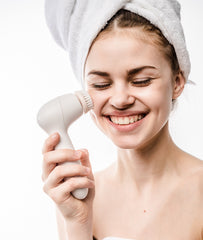Exfoliation is an important part of maintaining healthy skin. While our skin constantly produces new skin cells and sheds old, dead ones, natural aging, sun damage and acne can slow the renewal process and cause skin to look and feel dull, rough, and dry. Exfoliation can remedy these issues and result in smooth, hydrated, glowing skin. It can also help improved texture and tone, lightened pigmentation, unclogged pores, a clearer complexion, reduction in acne breakouts, and reduction in the appearance of fine lines and wrinkles.

When we think of exfoliation, our minds often go to harsh walnut scrubs and severe chemical peels – the former can cause microscopic tears and inflammation in the skin which allows bacteria or infection to fester, and the latter is an extreme measure that is not suitable for regular use for most skin types.
For proper exfoliation, there are a few different methods: mechanical exfoliation, chemical exfoliation, retinols, and enzymes. It is a matter of finding the appropriate method that increases skin benefits without over-exfoliating, increasing sensitivity, or the chances of causing inflammation and irritation.
Mechanical Exfoliation
Scrubs can cause inflammation, which is avoidable as long as the ingredients are gentle. If the scrub includes exfoliating beads, beads such as spherical jojoba beads are best, as they buff the skin vs stripping it.
Microdermabrasion uses a small, suction-head tip to shoot a jet of small abrasive crystals (usually aluminum or magnesium oxide) onto the skin to lift up dead skin cells, which are then removed in a vacuum-like process.
Chemical Exfoliation
This form uses alpha hydroxy acids (AHAs) and beta hydroxy acids (BHAs) to gently dissolve the outermost layers of skin, therefore encouraging cellular turnover and bringing new, healthy cells to the surface.
AHAs are water soluble and do not penetrate as deep within the skin, while BHAs are oil soluble and often penetrate much deeper. In general, AHAs are good for eliminating dead skin cells on the surface that result from sun damage, while the oil solubility of BHAs make them better for clearing up clogged pores. Common AHA sources include: glycolic acid, lactic acid, citric acid, malic acid, mandelic acid, tartaric acid.
Salicylic acid is the most common BHA and is highly-effective for acne treatment. Because it is oil soluble, it has the ability to penetrate through the oils in the skin and clear out follicles of excess debris and skin cells.
Oftentimes these chemical ingredients will be layered and used as a chemical peel, which, depending on your skin type and tolerance, can be extremely effective in improving texture, tone, tightness and pigmentation.
Retinol
Retinol is an extremely effective cell communicating ingredient which can connect to almost any skin cell and command it to behave like a healthy, younger cell. It can also act as an antioxidant that interrupts free radical damage. In many different ways, including exfoliation, retinol can help manage acne, discoloration and wrinkles.
Too much cell turnover can be damaging and cause dryness, flaking, and irritation, so keep exfoliation to one to two times a week.
Enzymes
Fruit enzymes from papain (papaya) and bromelain (pineapple) are proteolytic (protein digesting) substances meaning they absorb dead skin cells. In addition, these enzymes promote collagen production and leave skin brighter, smoother and fresher in appearance.
* DP Dermaceuticals are specifically made for pre and post-microneedling care for optimal results from your treatment *







